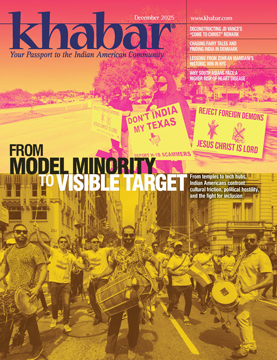Classical to Contemporary

South Asian performing artists in America are modernizing traditional Indian dance, music, and literature for both Indian American and mainstream audiences. Their challenge lies in blending authenticity, innovation, and fusion—not to mention the dilemma of secularizing traditions that are deeply rooted in religion.

Garba 360 was among the many featured events at “India Week” at the Lincoln Center for the Performing Arts in New York City. (Photo: Anne Whitman)
Traditional folk dancers flowing mesmerizingly in concentric circles in a garba have the power to pull onlookers into a trance. The vibrant colors of the traditional Gujarati chaniya-cholis and kediyas adorned by the dancers, the perfect synchrony of their graceful movements, and the folk songs and music that provide the backdrop to this beloved dance form—all of it make for a truly rich cultural immersion.
Steeped in such immersion in Garba is how Heena Patel grew up in Toronto, Canada. From childhood, she has been happily spinning in circles at Garba events that took over high school gymnasiums and stadiums in suburban Toronto during the Navaratri season. Her passion for it continued in college, where she led a competitive raas club while earning her bachelor’s degree in engineering at the University of California, Berkeley. She now runs Garba 360, an initiative to celebrate and promote this traditional Gujarati folk dance in North America.

Even beyond “India Week”, the Lincoln Center features concerts of talented Indian artists. Here is a poster promoting “an evening of Manganiyar, Dhrupad, and Bharatanatyam Dance” at the Center.
Elite Performing Arts Centers are Championing Indian Events
The vision of Indian performing artists, such as Heena Patel, of spreading the joy of rich Indian trditions is being increasingly embraced by storied American venues. Last summer, the Lincoln Center for the Performing Arts in New York City celebrated “India Week” as part of its Summer in the City series. In its third year, the series covered 300 events over nine weeks and 10 stages, underscoring how community engagement in the arts helps strengthen civic bonds.
Shanta Thake, the Chief Artistic Officer at Lincoln Center for the Performing Arts, said that when curating the India Week program and selecting the artists, her teams considered how to “complicate” the narrative of what it means to be Indian or to represent India. “It was important for us to make sure we were representing a multitude of styles, genres, but also religions, family structures, sexual orientations, and everything in between in making sure everyone sees a part of themselves in this India narrative.”

 Grammy award winner Chandrika Tandon’s 2019 performance of her album "Shivoham" at the Kennedy Center in Washington, DC was the world premiere of a musical journey focused on peace, love, and blessings. (Photos: Yassine El Mansouri)
Grammy award winner Chandrika Tandon’s 2019 performance of her album "Shivoham" at the Kennedy Center in Washington, DC was the world premiere of a musical journey focused on peace, love, and blessings. (Photos: Yassine El Mansouri)
The Lincoln Center is one of many elite centers giving desi performance arts a heightened focus on the main stage. Songwriter and producer Chandrika Tandon’s 2019 performance of her album "Shivoham" at the Kennedy Center in Washington, DC, was the world premiere of a musical journey focused on peace, love, and blessings. The 90-minute concert, performed to a packed capacity crowd, featured a blend of ancient Sanskrit mantras, English prayers, and various musical styles that included Western modes, Indian ragas, African and Spanish styles, jazz, and Gregorian chants. With an ensemble of 10 world-class musicians and two dozen choir singers, the album was recorded at nine studios in four countries—a collaboration that perfectly epitomizes cross-cultural aspirations and outreach.
Tandon went on to win the 2025 Grammy Award for her album "Triveni" in the Best New Age, Ambient, or Chant Album category.
These events, hosted by reputed mainstream venues, are also often interactive, offering audiences the opportunity to interact directly with artists. Closer to home, the Atlanta Symphony Orchestra’s “Visions of India” festival in 2023, centered around a performance by sarod maestro Amjad Ali Khan, was also an effective method of cross-cultural outreach.
Gaetan Le Divelec, Vice President of Artistic Planning at the Atlanta Symphony Orchestra (ASO), has coordinated fusion orchestra performances for many years. He believes that a certain level of translation is required to create harmony.
Hosting Khan and pairing it with a festival featuring local talent came about from Le Divelec’s professional partnership with the sarod master, which started in the early 2000s when he was an agent for one of London's major classical music agencies. “One of the things that became clear to me quite quickly is that, on so many levels, it would make so much sense to bridge Western classical and Indian classical music when there is such a large population of Indian heritage,” he says. “There aren't many world music traditions as sophisticated as the Indian or the Western classical.”
“I have a certain degree of comfort with Indian culture, but what's important with these kinds of initiatives is to be aware of one's own limitations. I happily bring [folks from within the community] to help me understand what would work for this community,” Le Divelec says. He notes that the Atlanta event drew Indian community members who had never been to an ASO concert previously while exposing their regular patrons to a new form of art. “I think that's where you get a real win. You're kind of expanding the horizon for both groups.”
Le Divelec is hopeful that the second—and third-generation wave of artists and audiences will become strong exponents of classical music. He is doing his part for this cause. The second Visions of India Festival, scheduled for this October (to coincide with Diwali), will feature composer Reena Esmail, who he credits for gracefully blending Western orchestra and Hindustani music in her piece “The Voice of Nature.” Other artists for the upcoming Fall season event are leading Indian American composer and multimedia artist Nina Shekhar, Hindustani violinist Kala Ramnath, and conductor Vinay Parameswaran.

Atlanta Symphony Orchestra’s “Visions of India” festival in 2023 centered around a performance by sarod maestro Amjad Ali Khan.
A Multitude of Considerations for Modern Artists
The responsibility of interpreting rich ancient traditions for modern audiences is not an easy one. From simply making the art form more accessible and appealing in a time and place far removed from its origins to not offending the increasing sensitivities of a woke population, today’s artists have to contend with a host of considerations. They must be willing to embrace experimentation, innovation, and fusion—while striving to remain true to the traditions that gave them the art form in the first place.
Sonny Singh, who performed at the Lincoln Center’s “India Week”, recognizes the great responsibility he has assumed in presenting Chardi Kala, sacred Sikh verses of spiritual upliftment to a modern American audience. He sets hallowed lyrics to twangy guitar, defiant trumpet, and tabla beats to render genre-bending anthems of love and rebellion.
 [Left] “There aren't many world music traditions as sophisticated as the Indian or the Western classical.” says Gaetan Le Divelec, Vice President of Artistic Planning at the Atlanta Symphony Orchestra. (Photo: Benjamin Ealovega)
[Left] “There aren't many world music traditions as sophisticated as the Indian or the Western classical.” says Gaetan Le Divelec, Vice President of Artistic Planning at the Atlanta Symphony Orchestra. (Photo: Benjamin Ealovega)
Singh grew up surrounded by the sounds of Sikh kirtans, sufi qawwali, American ska, punk rock, and reggae. However, he didn’t revisit kirtans (devotional music) until he felt the need for spiritual upliftment in adulthood. He was on the brink of despair after the 2016 U.S. election, thanks to Donald Trump’s Muslim ban, rising White nationalism, and Draconian policies that were also sprouting up in other parts of the world. He sought comfort in kirtans. “I did it because I needed that ancestral wisdom and feeling of upliftment and grounding," Singh says. "I realize that so much of it is relevant to our world today. Sharing it has been powerful.”
Performing in the Age of Evolving Identities
Singh’s music has gained a following through NPR Music, Songlines, and Bandcamp. The response has been generally positive, with a few exceptions coming from his challenging traditional identities surrounding nationality. For his India Week performance, he intentionally described his music as rooted in Sikh and Punjabi traditions rather than Indian.
“The notion of Indian identity being tied to that nation-state is deeply problematic. I think we need to expand what it means and do everything we can to uplift the voices of Indian Muslims, Sikhs, Christians, Dalits, and Bahujans, as well as non-Indian South Asians such as Sri Lankans, Pakistanis, Bangladeshis, and Nepalis. Our communities and histories are very linked and arbitrarily separated by borders,” Singh says.
 Singh’s latest album, Sage Warrior, was released last fall and provides listeners with a multisensory experience. It is paired with a book by Singh’s friend, Valarie Kaur, which is a retelling of Sikh history from the perspective of modern women.
Singh’s latest album, Sage Warrior, was released last fall and provides listeners with a multisensory experience. It is paired with a book by Singh’s friend, Valarie Kaur, which is a retelling of Sikh history from the perspective of modern women.
[Right] “We need to expand what it means to be Indian Muslims, Sikhs, Christians, Dalits, and Bahujans, as well as non-Indian South Asians such as Sri Lankans, Pakistanis, Bangladeshis, and Nepalis. Our communities and histories are very linked and arbitrarily separated by borders,” says singer-songwriter Sonny Singh. (Photo: Shruti Parekh).
Curating the “Complicated”
Other headliners are less green in bending identity and genre norms. Renowned performer DJ Rekha (they/their) is now turning their attention to curating diverse experiences instead. In a silent disco experience, Rekha delivers music to the audience through individual headsets for each participant. “It has an immersive feel, and you just dance,” they say.
This pioneer of underground bhangra rose to fame with "Basement Bhangra," a popular New York nightclub in the nineties, for which they supplied the soundtrack. Though it served as a foundational part of their journey, Rekha now finds that the word bhangra has also become limiting. Now, as a curator, they have the pleasure of experimenting with sounds and set designs to create eclectic and inclusive productions.
For India Week, Rekha’s lineup included Offering Rain, a Gujarati-Ecuadorian performer; DJ Ashu, who leans towards Bollywood beats, has played for numerous queer events; New York native and downtown staple DJ Rajuju Brown; and DJ Raat Ki Rani of Trinidadian descent. It was important for Rekha to include an artist of Indo-Caribbean descent in the India Week show, given that community’s role in the diaspora in New York City. According to Rekha, "There is nothing more fun to dance to than chutney soca."
The Dilemma of Secularizing Religious Traditions
For Heena Patel of Garba 360, the dance form holds spiritual significance since it was typically performed in honor of the Hindu goddess Durga. But in recent decades, the garba has increasingly become cultural if not simply recreational—to the dismay of some purists. “In the diaspora, some people see it as secular, others as religious. I’m mindful—with Hindu nationalism and the divisions on religion—of it as a folk art. We’ve been doing this dance, even within India, with non-Hindus, for a very long time.” Patel recalls dancing in Ahmedabad alongside Muslims, Sikhs, and Jains alike.
 Yet, Patel strives to highlight the symbolic meaning of the garba. She starts all dance lessons by explaining to participants that the concentric circles of Garba represent the womb, or “Mataji,” the mother goddess. However, the deity is not present at the center of the dance floor during Garba 360’s inclusive events. Dancers of all backgrounds can dance comfortably in their shoes if they wish.
Yet, Patel strives to highlight the symbolic meaning of the garba. She starts all dance lessons by explaining to participants that the concentric circles of Garba represent the womb, or “Mataji,” the mother goddess. However, the deity is not present at the center of the dance floor during Garba 360’s inclusive events. Dancers of all backgrounds can dance comfortably in their shoes if they wish.
[Left] To create an immersive experience, renowned performer DJ Rekha delivers music to the audience through individual headsets for each participant. (Photo: Sharmeen)
Experimentation is essential in solving the puzzle of bringing desi arts rooted in faith-based traditions to wider audiences. In Chicago, dancer and choreographer Pranita Nayar has been trying strategies to bring Bharatanatyam to the general public by steering clear of its religious themes. In 2014, to expand her repertoire beyond Bharatnatyam, she founded Mandala South Asian Performing Arts. For a Diwali-centered event, she proposed a Ram Leela show to the Harris Theater for Music & Dance. While the Theater loved the idea, it faced public backlash when the performance hit the stage. “The concept of Diwali in a faith-based program did not go well with some segments of the community,” Nayar says. She feels that religion is intrinsic to Indian art forms. “How do we separate it?”
At the same time, Nayar observes that her casting choices may have also lost her favor with some traditional Hindu audiences. At the Harris show of Ram Leela in 2022, Ram was played by a black American dancer. A year prior, Nayar had cast Laksha Dantran, who identifies as transgender, in the lead role of Ram for a performance at the Naper Settlement.
Lack of Community Support
Community support to sustain professional ensembles for Indian classical dance is tepid, laments Nayar. Having conducted 50 arangetrams (a rite of passage from student to performer), Nayar says parents in the community are not willing to support a professional ensemble in the same way that they are willing to fund their child’s debut performance.
She’s trying to cultivate greater interest in Bharatanatyam for the community to support professional dance troupes, but interest is limited.
“The fault lies with the community. They will not come and buy a ticket or donate for the ensemble to survive,” she says.
Is Fusion the Answer?
For years, Nayar has tried to solve the puzzle of tweaking Bharatanatyam to make it interesting and relevant to a wider audience. “It’s complex. I’m still in the process of figuring it out,” she says. Using the platform that the Harris Theater has provided, Nayar has found success when combining classical art with other dance forms, particularly folk dance.
However, with the fusion of forms, there are other complexities to maneuver. For instance, elite performing arts institutions typically include live orchestras. Rehearsing for these becomes challenging because Indian musicians tend not to follow written notes, while Western orchestras do, Nayar says. The former play music based on their knowledge of the raga, and improvisation is encouraged. This can be difficult for theater sound technicians, who are not familiar with classical Indian music, Nayar notes.
Like Nayar, Composer Reena Esmail, who is one of those to be featured in Atlanta Symphony Orchestra’s Visions of India event later this year, recognizes that Hindustani music, for instance, has an improvisational component that isn’t recorded in notes. Artists who are familiar with the ragas can riff off one another. Western classical music, however, is meticulously notated and, as a result, has evolved in a different direction.
 Esmail, a product of interfaith, multicultural influences, was raised by a Muslim father and a Catholic mother. Growing up in Hollywood, California, she did not have exposure to other Indian kids who had a similar background—religiously Catholic but socially Muslim.
Esmail, a product of interfaith, multicultural influences, was raised by a Muslim father and a Catholic mother. Growing up in Hollywood, California, she did not have exposure to other Indian kids who had a similar background—religiously Catholic but socially Muslim.
[Right] After her Ram Leela show at Chicago’s Harris Theater for Music & Dance, dancer and choreographer Pranita Nayar has been trying strategies to bring Bharatanatyam to the general public by steering clear of its religious themes. (Photo source: seechicagodance.com)
In her youth, Esmail’s music studies focused on piano, guitar, and some violin. It wasn’t until she completed her undergraduate degree at the Conservatory in Western classical music that she started to explore Hindustani music. She was the only Indian woman in her cohort at the time to study composition at The Juilliard School, where her teachers were trying to figure her out. They wondered if she would compose Indian music, but she hadn’t given it thought because she hadn’t been trained in the Indian style.
“At that time, I didn’t know enough about it to be confident, but I didn’t want to bastardize it because it was my own tradition,” she says. But her interest grew, and she felt a desire to make music with people who shared her culture. At the time, she was living in New York and had started meeting people to exchange musical ideas. She didn’t find a true pathway to Indian music until she pursued her master’s degree at Yale School of Music. She worked with a teacher whom Yale hired from Delhi to begin learning Hindustani music. Esmail eventually landed a Fulbright scholarship that allowed her to connect to teachers in India, which she used as an exploration into her roots. Esmail became musically bilingual.
“When I speak to Indian classical music, I’m talking about counting aavartans, improvising in various ragas—and then I will turn around and speak to Western musicians about harmonies, bowings, articulations. Even how I move my hand to cue someone to play is completely different based on the tradition in which they are trained. I love speaking both musical languages and switching back and forth between them so quickly that they become a synthesized style.”
 She says that speaking the same language as musicians is crucial for earning their trust and respect. Much of her effort up front goes to serving as a translator. Esmail finds more vertical harmony and counterpoint, a Western musical technique involving multiple melodic lines, which has no equivalent in Hindustani music.
She says that speaking the same language as musicians is crucial for earning their trust and respect. Much of her effort up front goes to serving as a translator. Esmail finds more vertical harmony and counterpoint, a Western musical technique involving multiple melodic lines, which has no equivalent in Hindustani music.
Rather than use music as a conduit to cultural traditions, Esmail considers her work a handshake that brings traditions together. “What people hear is through their own lens,” Esmail says, recounting examples of when her listeners have applauded her use of a specific raga or taal in a symphony composition.
[Left] “I want to honor the core values of each tradition and also provide beautiful, warm, and engaging music and then let that music lay the groundwork for a deeper mutual understanding,” says composer Reena Esmail, whose steep qualifications and proficiency in both Western and Indian classical styles allows her to finesse fusion between the two. (Photo: Rachel Garcia)
She particularly remembers composing a piece for a high school band in Naperville, Illinois. By incorporating Raga Bhimpalasi into the piece, Esmail helped bridge a gap between the desi band students and their families. The younger performers may not all have known the raga’s name, but they were excited to see a glimmer of recognition in the eyes of their parents and grandparents, who were familiar with the melody and would not have otherwise connected with the band’s repertoire.
While she recognizes that both Western and Indian classical styles of music started from deep-seated religious or spiritual origins, her goal is to have a repertoire that covers the gamut of traditions. “What I have to think about carefully is, when dealing with one specific spiritual tradition, how do I open things up?” she says. “I want to honor the core values of each tradition and also provide beautiful, warm, and engaging music and then let that music lay the groundwork for a deeper mutual understanding.”
Amritha Alladi Joseph, a former reporter for Gannett newspapers, The Hindu, The Gainesville Sun, Gainesville Magazine, and CNN-IBN, is now a customer success strategist at Salesforce.
Enjoyed reading Khabar magazine? Subscribe to Khabar and get a full digital copy of this Indian-American community magazine.
blog comments powered by Disqus










